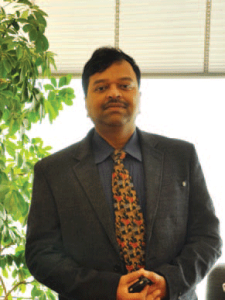Banking nowadays is more about how innovative the funding structure can be, rather than the proverbial ‘offering the best service’. This is the view of a leading Gulf investment house, which explains its rationale to PAUL MELLY
As global economic recovery takes hold, the Gulf’s major companies are gearing up to seize fresh opportunities – but it is vital to build new growth on solid foundations. And that is certainly the view at KAMCO (KIPCO Asset Management Company), one of the leading investment houses in Kuwait.

After a rigorous strategic overhaul, the group is preparing to push forward once more, and the business environment looks favourable.
“KAMCO’s key business is AMIB (asset management and investment banking) and the financial and economic indicators for both asset management and investment banking sectors have been very positive,” says Sriram Chandran Subramanian, the group’s chief financial officer.
“Though KAMCO is all geared up to cater to different segments of our customers and clients in equity, real estate, fixed income and private equity, we will still have a large focus on the equity markets, as our managed equity funds and the wider investment banking climate depend on the performance of the equity markets. In our opinion, after four years of a downward trend in the markets over 2009-2012, the equity markets started their upswing in 2013 – and we expect this to gain further momentum in 2014 and 2015.
“We all are aware that the regional markets are at less than one-third of their peaks of 2007 and 2008 and are set for a re-rating sooner rather than later. This scenario should help KAMCO in a positive way in 2014 and the following years.

chief financial officer.
“On the economic front, after a fall in 2009, the GDP of the GCC (Gulf Co-operation Council) region has been consistently on a growth path from 2010 onwards – and this is expected to continue northwards in the years to come. That will play a major role in the growth of our business, too.”
More capital efficient
Over the past two years, KAMCO has restructured its assets and liabilities to make its future earnings more capital efficient.
“We have reduced our assets by more than half in the last three years and have consequently made our equity and debt structure more efficient, too. Our asset growth in coming years will be in the core AMIB business, through seed funding of new managed funds, and less through other investments,” says Subramanian.
“In 2014, KAMCO will continue to focus on further strengthening its core AMIB business by launching more managed funds to service clients of different asset classes and by putting more resources into our investment banking side to enable us to garner a bigger market share of the increasing number of debt and equity issues and M&A (merger and acquisition) activities in the region.
“Our priority will be to ensure that financial resources are effectively employed in our core business, on both the equity and debt fronts, and to manage the efficiency of the cost of funding by consistently monitoring our banking facilities in light of the evolution of interest and foreign exchange rates. We also are continuously equipping ourselves with the best tools and processes, to keep the company strongly entrenched in the ever evolving corporate governance and compliance climate.”
KAMCO’a treasury activity is managed by a small dedicated team within the finance department.
“However,” notes Subramanian, “we ensure that we maintain a manageably wider network of banking relationships that can provide us with more choices and different competencies on the funding and forex transactions. We do believe in the concept of ‘thin resources and thicker choices’ when it comes to the efficient management of treasury.”
Treasury caution
Subramanian explains that KAMCO deals mainly in Kuwaiti dinars (KD). But the group has a range of investments and managed funds in US dollars and it also deals in other Gulf region denominations,
as it manages portfolios for its clients in various currencies.
The treasury team is watching the development of services on the Cloud with interest. But it thinks that at this stage that technology still carries risks.
“We believe in efficient resources within the company, and wider choice on the outside. We are aware that the world is moving towards Cloud computing and we may have little choice but to adopt it some day.
“However, as things stand today Cloud computing is still going through teething problems on the security and data control side, especially on the banking side: there are numerous threats of fraud, both internally within the banks and from external hackers,” says Subramanian.
“Adopting Cloud services for the accounting and business operational areas seems far less risky by comparison with the money side. But KAMCO prefers to wait and watch before embarking on the use of Cloud treasury services.”
Naturally, though, KAMCO regards continuing investment in its own internal systems as a crucial priority.
“We are always trying to keep pace with technological change and our systems have been regularly updated and upgraded to keep them robust and dependable, especially since we also manage the funds of our clients. The pace at which the technology is evolving today makes it a tough race to keep up in and our IT team constantly strives to bridge the gap through efficient spending,” explains Subramanian.
“Generally, we are of the opinion that a three-four-year time-frame is reasonable for bringing a system to to the next level – unless a breakthrough technology such as Cloud computing ‘unshackles’ the current technical constraints. But such a breakthrough technology still needs to be tried and tested if it is to gain wider acceptance.”
‘Selective’ strategy
KAMCO is open-minded about the range of banks that it might be willing to use.
“We base our treasury strategy on a ‘relationship with a manageably wider band’ of banks. Banking is as much about relationship as it is about cost and service efficiency.
“So having a select band of banks in our fold and trying to make them compete healthily among themselves for our business is the strategy we are adopting. We carefully balance the cost and relationship factors, as the recent financial crisis clearly showed how relationships matter much more than ruthless cost management.
“Kuwait has a wide choice of banks. However, when it comes to forex funding, companies generally tend to add external banks into the range of those they use, because of regulatory restrictions on forex funding by local banks. At the moment, KAMCO is using only local banks; but we have an open mind about adding new relationships, if they make economic and long-term relationship sense.”
So what are the key factors that matter most to KAMCO in assessing the services a bank offers ?
“KAMCO, with its growth strategy clearly focused on managed funds, will have a mixed basket of currencies to deal with in the coming years as we expand and grow into the region, after being mainly Kuwait-based, as we are now. So, for us, forex funding could be a key factor – and that translates into the need for a bank with international capacity,” says Subramanian.
“Another factor that we look at is banks’ capability in innovative structuring within prevailing regulatory frameworks. Banking nowadays is more about how innovative the funding structure can be, rather than the proverbial ‘offering the best service’.
The competitive element
However, Subramanian adds, KAMCO also regards the quality of the relationships it has with its current banks as an important factor.
“From the service point of view – the room for banks to make a difference may be limited, especially for a client like KAMCO, which already has a good reputation backed up by its parent company KIPCO.
“So, among our existing banks, we don’t generally have favourites. Basically, we look at how best they can compete for our business while not jeopardising their own business economics.
“Being a financial service provider ourselves, we also have a give-and-take relationship with most of the banks and hence there are considerations beyond the basic banking economics that sometimes need to be factored into the balance.
“Forex and funding both are ever-evolving dynamics – and, hence, for a treasury team, both management tools and resources are key for success. But, equally, the support and advisory services of the banks will also always play a major role.”
 Cash And Trade Magazine For Cash and Trade professionals in the Middle East
Cash And Trade Magazine For Cash and Trade professionals in the Middle East




